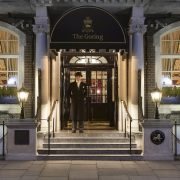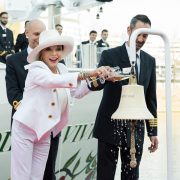The Ultimate Fashion Capital Guide
Fashion and travel go together and who can resist checking out scouring the fashion capitals of the world for something special.
Currys PC World in conjunction with Fossil and Michael Kors have put together The Fashion Travel Guide for those who love to follow the latest trends.
The guide highlights 12 fashion popular cities featuring key fashion events, the best areas to shop and the average cost of clothing.
London, Paris, Milan and New York may be the ‘big four’ of the fashion world, but with growing investment in the industry beyond these four mighty pillars, other cities are starting to move up the fashion ranks.
With expert insights from Justine Tabak, designer and founder of an eponymous sustainable fashion brand, paired with factors such as fashion schools and events, the world’s top fashion cities have been identified.
“Fashion has become ever more a democracy with a proliferation of start-ups and independents vying for attention amongst the classic giants of fashion. With this, new fashion centres emerge and create a multi-faceted global network of fashion brands.”
The top emerging fashion capitals
Traditionally, Europe and North America have dominated the fashion world, but thanks to the democratisation of the industry, fashion is now very much global. The Far East has become a fashion powerhouse in recent years, with cities like Tokyo and Seoul putting themselves firmly on the fashion map.
Elsewhere, cities such as Berlin, LA and Melbourne are championing a more laidback take on fashion, while the likes of Lagos and São Paulo bring something more eclectic to the mix.
“Street fashion and subcultures were popularised in Japan during the 80s and swept into mainstream culture alongside the developing obsession with anime, manga and comic book characters,” says Tabak. As for South Korea, “K Pop, K -Beauty and now K-Fashion has exploded in popularity. Aimed at youth culture, fashion trends are fast paced, with a mix of sportswear, vintage and tailored looks all worn together.”
The most notable fashion events and exhibitions
The traditional fashion calendar revolves around the bi-annual fashion weeks hosted in Paris, London, New York in Milan, but there are hundreds of other fashion weeks held in cities all around the world.
São Paulo Fashion Week has grown to become the fifth biggest in the world and is commended for its commitment for encouraging sustainability in fashion.
“São Paulo Fashion Week has garnered a colourful reputation for presenting the best of ethical and inclusive design. The city has grown into a progressive fashion hub, where designers focus their minds on the environment, with many leading the way in recycling and up cycling of materials,” says Tabak.
Key fashion events and exhibitions:
Paris – Paris Fashion Week; Première Vision; Palais Galleria
London – London Fashion Week; Graduate Fashion Week; Victoria and Albert Museum
Milan – Milan Fashion Week; MICAM; The Palazzo Morando
New York – New York Fashion Week; The Costume Institute; Fashion Institute of Technology (FIT)
Amsterdam – Amsterdam Fashion Week; Modefabrie
Berlin – Berlin Fashion Week; PREMIUM; Bread and Butter
LA – LA Fashion Week; LA Fashion Festival
São Paulo – São Paulo Fashion Week
Seoul – Seoul Fashion Week
Tokyo – Tokyo Fashion Week; Bunka Gakuen Costume Museum
Melbourne – Melbourne Fashion Week; Virgin Australia Melbourne Fashion Festival
Lagos – Lagos Fashion Week; Lagos Fashion Fair
After some retail therapy?
No fashion capital is complete without a strong shopping scene. While the likes of Paris and Milan are known for their luxury brand offerings, cities such as Amsterdam and Berlin are hot for vintage finds.
“Preloved and circular fashion has been a natural feature of Dutch living for many decades – it’s part of the Dutch psyche for green living. There’s even a museum in Amsterdam called ‘Fashion for Good’, which is dedicated to sustainable innovation and promoting best practice in fashion,” says Tabak.
And with the rising influence of street style, fashion is becoming more laidback. “Dressing down is the new dressing up,” says Tabak. “Whilst tailoring will always be valued, boundaries will continue to be blurred between smart and casual.” The same goes for blurring gender boundaries, with designers “presenting more loose fit androgynous shapes to women whilst men have more traditionally feminine touches on offer.”
Where to shop:
Paris – Forum de Halles (affordable fashion); the Golden Triangle (luxury brands); Montmartre (vintage)
London – Oxford Street (affordable fashion); Bond Street (luxury brands); Brick Lane (vintage)
Milan – Corso Vittorio Emanuele II (affordable); Quadrilatero della Moda (luxury brands); Brera district (vintage)
New York – Soho (affordable fashion); Madison Avenue (luxury brands); Bedford Avenue (vintage)
Amsterdam – Kalverstraat (affordable fashion); P.C. Hooftstraat (luxury brands); De 9 Straatjes (vintage)
Berlin – Alexanderplatz (affordable fashion); Kurfürstendamm (luxury brands); Flohmarkt im Mauerpark (vintage)
LA – The Grove (affordable fashion); Beverley Hills (luxury brands); Melrose Avenue (boutiques)
São Paulo – Morumbi Shopping Centre (affordable fashion); Rua Oscar Freire (luxury brands); Jardins (boutiques)
Seoul – Myeongdong Market (affordable fashion); Apgujeong (luxury brands); Insadong (vintage)
Tokyo – Shibuya (affordable fashion); Ginza (luxury brands); Harajuku (boutiques)
Melbourne – Chadstone (affordable fashion); Collins Street (luxury brands); Sydney Road (vintage)
Lagos – Palms Shopping Centre (affordable and luxury brands); Victoria Island (boutiques); Lekki Market (market stalls)
Details
To see the full fashion travel guide head here.










